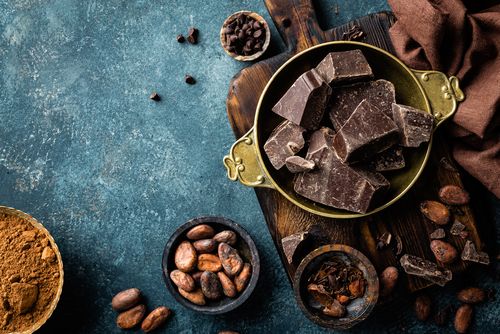
17 Aug For the Fondness of Chocolate
In the realm of eating, we could talk a whole lot about comfort foods: mashed potatoes and gravy with slow-cooked, fall-apart meat, fresh baked bread, hot with melted butter, having vegetables from planting to table, fresh fruit from orchard stands in the fall, and authentic dishes and spice combinations from cultures all over the world. There’s no question about it: food is something that’s essential, but it also makes us delighted. And sure, we love our favorite meals, but we also love desserts. And, in the realm of dessert, possibly no sweet treat is more enjoyed than chocolate.
From a typical, rich chocolate cake to chocolate dipped strawberries, and melt-in-your-mouth Lindt truffles to a soft, homemade chocolate chip cookie, there’s nothing quite like it. It gives all the feels, and gives most of us a culinary adventure we want to have repeatedly.
Today we go and buy perfectly packaged chocolate bars at the supermarket (maybe guiltily putting them in our purse for clandestine consuming), purchase boxes of our favorites for gifts, buy the richest hot chocolate mixes for cold winter nights around the fire, or get unsweetened blocks of it to use in baking. Anciently, it was actually first consumed as a bitter, frothy drink. Afterwards, sugar or honey were included in give it a sweeter flavor, and what we’ve done with cocoa beans has continued to change over time: adding cocoa butter (fat that is taken from the cocoa bean) back into the chocolate liquor to yield firm chocolate that you can mold into different shapes, adding milk powder in to create milk chocolate, and conching, a machine that was invented by Rodolphe Lindt in the 1800s. Conching, in particular, accounts for chocolate that is uniform and smooth in texture.
But how do we get it from the beginning? It stems from the cacao tree, where seeds grow in pods. The seeds are taken out of the pods and then undergo a fermentation process when they are fully ripe. Once that is done, they are roasted, and cocoa nibs are detached from the seed husks. Those nibs are then ground and ultimately liquefied into what we known as chocolate liquor– which is, at its basic, fundamental level, pure chocolate.
That chocolate liquor is then combined with sugars and cocoa butter, to varying degrees, yielding the different types of chocolate bars we buy in the stores. White chocolate isn’t made with any of the chocolate liquor, though; in that case, the only ingredient that comes from the cocoa bean is the extracted cocoa butter, or fat, that is then combined with other factors to make something sweet and yummy.
But, you’re probably reading this and thinking, “Yeah, I’m a big chocolate fan so this is all fine and good, but what in the world does it relate to motorcoaches?” Thanks for the question, my friend, because we have the answer. While coaches are probably most well-known for group tour transportation, we offer many other services at the same time. One of these is culinary tours, opportunities for foodies to expand their knowledge about several cooking techniques, combining new flavors, or making signature dishes and desserts. If this seems like something you’d enjoy, contact us today to find out more information. Who knows? You just might end up learning some new things to do with chocolate that will revolutionize your dinner parties for the coming year!
(The following source presented information for this article: https://en.m.wikipedia.org/wiki/Chocolate).


No Comments